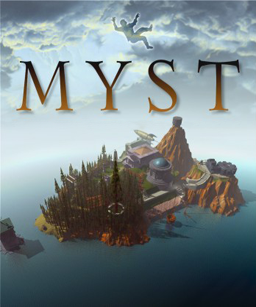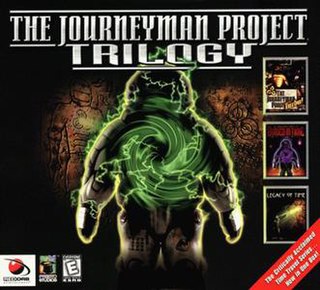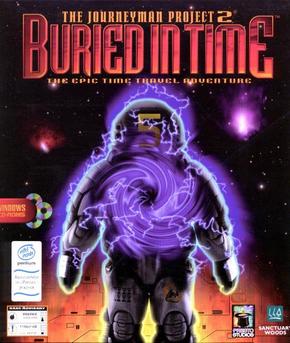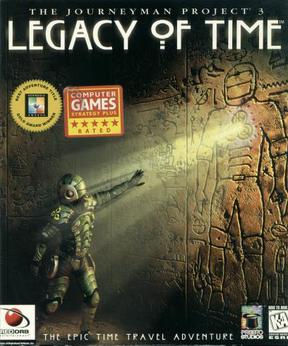
Myst is a graphic adventure/puzzle video game designed by the Miller brothers, Robyn and Rand. It was developed by Cyan, Inc., published by Broderbund, and initially released for the Macintosh in 1993. In the game, the player's character travels via a special book to the island of Myst. From there, solving puzzles allows the player to travel to four other worlds which reveal the backstory of the game's characters, one of which the player must eventually choose to aid.

The Journeyman Project is a time travel adventure computer game developed by Presto Studios.

Riven is a puzzle adventure video game. It is the sequel to Myst and second in the Myst series of games. Developed by Cyan Worlds, it was initially published by Red Orb Entertainment, a division of Broderbund. Riven was distributed on five compact discs and released on October 31, 1997, in North America; it was later released on a single DVD-ROM on August 17, 1998, with improved audio and a fourteen-minute "making-of" video. In addition to the PC versions, Riven has been ported to several other platforms.

Uru: Ages Beyond Myst is an adventure video game developed by Cyan Worlds and published by Ubisoft. Released in 2003, the title is the fourth game in the Myst canon. Departing from previous games of the franchise, Uru takes place in the modern era and allows players to customize their onscreen avatars. Players use their avatars to explore the abandoned city of an ancient race known as the D'ni, uncover story clues and solve puzzles.

Cyan, Inc., also known as Cyan Worlds, Inc., is an American video game developer. Founded as Cyan Productions by brothers Rand and Robyn Miller in 1987, the company is best known as the creator of the Myst series. The company is located in Mead, Washington, just outside Spokane.

Myst III: Exile is the third title in the Myst series of graphic adventure puzzle video games. While the preceding games in the series, Myst and Riven, were produced by Cyan Worlds and published by Brøderbund, Exile was developed by Presto Studios and published by Ubi Soft. The game was released on four compact discs for both Mac OS and Microsoft Windows on May 8, 2001; versions for the Xbox and PlayStation 2 were released in late 2002. A single-disc DVD version was later released for Windows and Mac OS.

Myst IV: Revelation is an adventure video game, the fourth installment in the Myst series, developed and published by Ubisoft. Like Myst III: Exile, Revelation combines pre-rendered graphics with digital video, but also features real-time 3D effects for added realism. The plot of Revelation follows up on plot details from the original Myst. The player is summoned by Atrus, a man who creates links to other worlds known as Ages by writing special linking books. Almost twenty years earlier, Atrus' two sons nearly destroyed all of his books and were imprisoned; Atrus now wishes to see if his sons' imprisonment has reformed them. The player travels to each brother's prison, in an attempt to recover Atrus' daughter Yeesha from the brothers' plot.
Myst is a franchise centered on a series of adventure video games. The first game in the series, Myst, was released in 1993 by brothers Rand and Robyn Miller and their video game company Cyan, Inc. The first sequel to Myst, Riven, was released in 1997 and was followed by three more direct sequels: Myst III: Exile in 2001, Myst IV: Revelation in 2004, and Myst V: End of Ages in 2005. A spinoff featuring a multiplayer component, Uru: Ages Beyond Myst, was released in 2003 and followed by two expansion packs.

The Journeyman Project is a series of award-winning first-person science fiction adventure games, created by Presto Studios and released by various publishers, including Bandai, Sanctuary Woods, and Red Orb Entertainment.

Myst V: End of Ages is a 2005 adventure video game, the fifth installment in the Myst series. The game was developed by Cyan Worlds, published by Ubisoft, and released for Macintosh and Windows PC platforms in September 2005. As in previous games in the series, End of Ages's gameplay consists of navigating worlds known as "Ages" via the use of special books and items which act as portals.

Cosmic Osmo and the Worlds Beyond the Mackerel is a graphic adventure computer game for the Macintosh computer line created by Cyan, Inc. It was published in 1989 and won the 1990 Mac User's Editors' Choice Award for the "Best Recreational Program" category.

Over one hundred video games based on the Star Wars franchise have been released, dating back to some of the earliest home consoles. Some are based directly on films while others rely heavily on the Star Wars Expanded Universe.

Whacked! is a party game developed by Presto Studios and released in 2002 by Microsoft Game Studios exclusively for the Xbox. It was one of the two original games to be made available for Xbox Live, and it received mixed reviews. Whacked! was the last game developed by Presto Studios before it went defunct.

Amber: Journeys Beyond is an American computer game released in 1996 for Apple Macintosh computers and Windows 95. It is the only game produced by Hue Forest Entertainment, founded by Frank and Susan Wimmer.
Mac gaming refers to the use of video games on Macintosh personal computers. In the 1990s, Apple computers did not attract the same level of video game development as Microsoft Windows computers due to the high popularity of Microsoft Windows and, for 3D gaming, Microsoft's DirectX technology. In recent years, the introduction of Mac OS X and support for Intel processors has eased porting of many games, including 3D games through use of OpenGL and more recently Apple's own Metal API. Virtualization technology and Boot Camp also permit the use of Windows and its games on Macintosh computers. Today, a growing number of popular games run natively on macOS, though as of early 2019, a majority still require the use of Microsoft Windows.

The Journeyman Project 2: Buried in Time is a computer game developed by Presto Studios and is the second game in the Journeyman Project series of computer adventure games.

The Journeyman Project 3: Legacy of Time is a computer game developed by Presto Studios and is a sequel to The Journeyman Project and The Journeyman Project 2: Buried in Time.

Krome Studios Pty Ltd. is an Australian video game company. Its headquarters were in Brisbane and it previously had offices in Adelaide and Melbourne. Krome Studios is best known for their Ty the Tasmanian Tiger games and for their reboot of the Spyro the Dragon series. Krome has created games for the Xbox, GameCube, Wii, Game Boy Advance, Dreamcast, PlayStation, PlayStation 2, Macintosh and PC. Krome has also developed for Xbox 360, PlayStation 3, Wii, PlayStation Portable, Windows Phone 7 and iOS.

Beenox Inc. is a Canadian video game developer established in 2000 in Quebec City, Quebec, Canada. The studio became a wholly owned subsidiary of Activision on May 25, 2005.

The Journeyman Project: Pegasus Prime is an adventure computer game developed by Presto Studios and published by Bandai in 1997. It is a complete remake of the original Journeyman Project, using some of the actors from The Journeyman Project 2: Buried in Time.


















